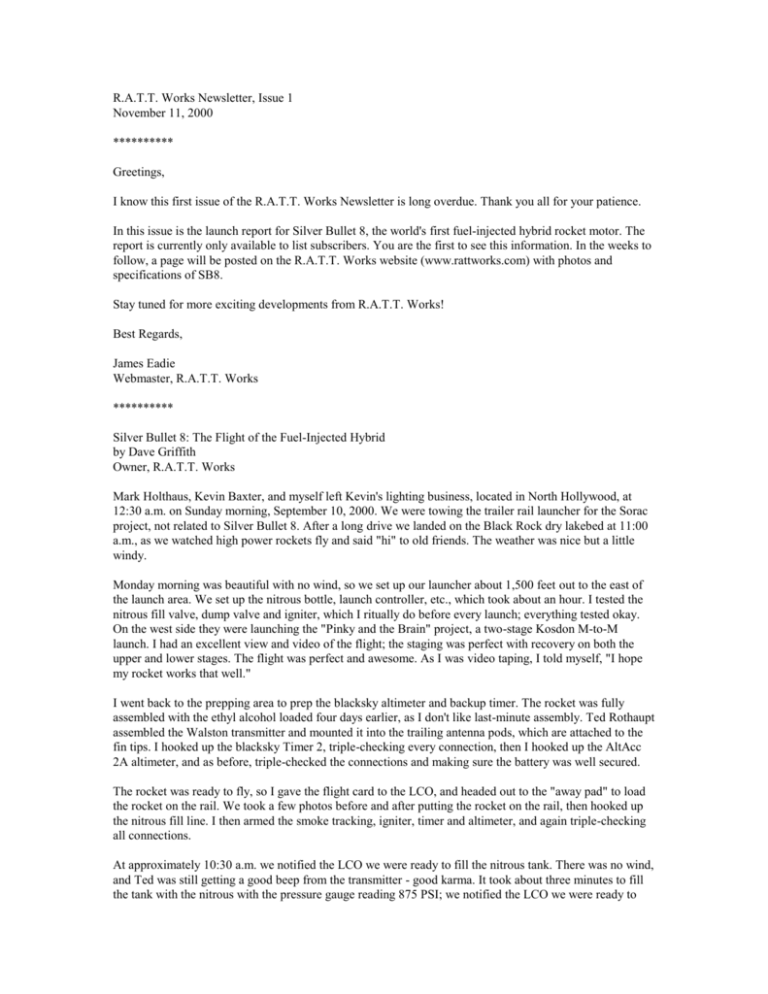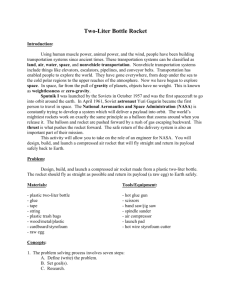Silver Bullet 8 newsletter
advertisement

R.A.T.T. Works Newsletter, Issue 1 November 11, 2000 ********** Greetings, I know this first issue of the R.A.T.T. Works Newsletter is long overdue. Thank you all for your patience. In this issue is the launch report for Silver Bullet 8, the world's first fuel-injected hybrid rocket motor. The report is currently only available to list subscribers. You are the first to see this information. In the weeks to follow, a page will be posted on the R.A.T.T. Works website (www.rattworks.com) with photos and specifications of SB8. Stay tuned for more exciting developments from R.A.T.T. Works! Best Regards, James Eadie Webmaster, R.A.T.T. Works ********** Silver Bullet 8: The Flight of the Fuel-Injected Hybrid by Dave Griffith Owner, R.A.T.T. Works Mark Holthaus, Kevin Baxter, and myself left Kevin's lighting business, located in North Hollywood, at 12:30 a.m. on Sunday morning, September 10, 2000. We were towing the trailer rail launcher for the Sorac project, not related to Silver Bullet 8. After a long drive we landed on the Black Rock dry lakebed at 11:00 a.m., as we watched high power rockets fly and said "hi" to old friends. The weather was nice but a little windy. Monday morning was beautiful with no wind, so we set up our launcher about 1,500 feet out to the east of the launch area. We set up the nitrous bottle, launch controller, etc., which took about an hour. I tested the nitrous fill valve, dump valve and igniter, which I ritually do before every launch; everything tested okay. On the west side they were launching the "Pinky and the Brain" project, a two-stage Kosdon M-to-M launch. I had an excellent view and video of the flight; the staging was perfect with recovery on both the upper and lower stages. The flight was perfect and awesome. As I was video taping, I told myself, "I hope my rocket works that well." I went back to the prepping area to prep the blacksky altimeter and backup timer. The rocket was fully assembled with the ethyl alcohol loaded four days earlier, as I don't like last-minute assembly. Ted Rothaupt assembled the Walston transmitter and mounted it into the trailing antenna pods, which are attached to the fin tips. I hooked up the blacksky Timer 2, triple-checking every connection, then I hooked up the AltAcc 2A altimeter, and as before, triple-checked the connections and making sure the battery was well secured. The rocket was ready to fly, so I gave the flight card to the LCO, and headed out to the "away pad" to load the rocket on the rail. We took a few photos before and after putting the rocket on the rail, then hooked up the nitrous fill line. I then armed the smoke tracking, igniter, timer and altimeter, and again triple-checking all connections. At approximately 10:30 a.m. we notified the LCO we were ready to fill the nitrous tank. There was no wind, and Ted was still getting a good beep from the transmitter - good karma. It took about three minutes to fill the tank with the nitrous with the pressure gauge reading 875 PSI; we notified the LCO we were ready to launch. The gave us a 10 count, at T -1 Ted hit the ignition button, which ignited the FireStar igniter and also ignited the smoke tracking located in a special compartment above the motor and below the parachute. These were wired in parallel to ignite at the same time. The FireStar igniter ignited the solid propellant starter grain, which burnt through the Urbanski/Colburn fill line, and the motor came to life. This sequence took about one second; the motor was in hybrid mode, with mach diamonds in full view. After leaving the launch rail, at about one-half of a second later, the central alcohol plug burnt through, releasing the alcohol into the chamber, giving it a long rich flame. The rocket quickly accelerated as the ABS plastic hybrid fuel grain was totally consumed in about three seconds. Now the rocket was in high-performance bipropellant mode; observers noted a visible increase in acceleration. The motor burned for another six seconds with a colorless alcohol flame, and we could easily see the tracking smoke as it climbed to its peak altitude. We could barely see the parachutes when they deployed. The booster had a RocketMan R3C 'chute, backed by a Pratt Hobbies Nomex 'chute protector. (Yes, I know it's small, but I wanted to get it back for evaluation.) The payload section had an Aerocon three foot silk 'chute. With the sun in the background it stood out like Venus in the daytime. The smoke tracking continued to burn for about two minutes, which gave the recovery crew a good visual to track on. I looked away for about ten seconds, and when I looked back I could not see the payload parachute (It must have drifted into the Sun). We grabbed our cameras and followed Kevin's truck a.k.a. the recovery crew. He was about two-and-a-half miles away and recovered the booster and was on his way back when we met up with him. We saw the booster but no payload section, arggg! Ted, Scott, and I drove around for about half an hour looking for the payload section with all its data, and kept asking ourselves, "Why didn't we put an additional transmitter in the payload section?" We went back to the launch site and asked the LCO to announce that we were offering a R.A.T.T. Works K240 for a reward to anyone who found the payload section. We decided to try looking on the northeast section near where the booster had landed. As we were driving out that way, we spotted a black SUV coming towards us, driven by Jason Blatznen. He stopped and asked if we were looking for a payload section. I said, "Yes. Is it white with a black nose cone and florescent pink stripes?" He said, "Yes." What a relief! I offered him the reward, but he refused it. Rocket people are so cool. We packed up our area and left the lakebed to have lunch at Bruno's Cafe and look at the data on Kevin's laptop. It showed an altitude of 17,400 feet, with a burnout velocity of 1,032 feet per second. The rocket was stuck in a transonic region, which probably caused the lower than expected altitude, which was simulated at 25,000 feet. I guess I need a booster. :) Here are some of the details of the Silver Bullet 8. Diameter: 2.5 inches. Length: 10 feet. Constructed of all 6061-T6 aluminum, except for the nozzle and combustion chamber liner. The oxidizer was 5.5 lbs. of nitrous oxide. The fuel was 1.5 lbs. ethyl alcohol, and the hybrid grain 0.25 lbs. of ABS plastic. Total loaded weight: 20 lbs. Post-flight analysis back at the shop showed that the key motor components had almost zero erosion and very little of the ablative combustion chamber liner was removed. It only took four years of research and development to get it to work this well. To my knowledge, no amateur has flown a liquid propellant rocket, recovered by parachute intact and retrieved data. ****end****











